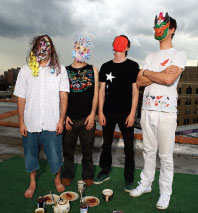 |
(Photo: Courtesy of Motormouth Media) |
Animal Collective is as strange a young rock band as New York has ever known. They play music full of psychedelic noise, with peculiar vocals arranged in choral yelps. They answer to cryptic character names—Avey Tare, Panda Bear, Geologist, and Deacon—and have been known to dress as giant turtles and rabbits with bloody fur.
They also managed to draw 3,500 people to South Street Seaport for a concert this summer. Some were clearly tourists lured by tall ships and shopping, but most were fervid music scenesters eager to hear what one of New York’s underground treasures would do next.
In typical Animal Collective fashion, the show was a mess. One member of the band flailed around while screaming and banging on things (some of them drums). Another stood behind a mixer, turning knobs and singing gorgeous harmonies worthy of the Beach Boys at their most ornate. Yet another sat on the stage with a spelunking lamp on his head. But amid this chaos of sights and sounds, they crafted a musical experience that proved transporting to those who managed to pay close attention. (Among them were Sofia Coppola and the Brazilian sixties-rock legend Caetano Veloso, who went shopping for Animal Collective CDs the next day.)
That same otherworldly quality infuses Strawberry Jam, Animal Collective’s sixth album since starting out in New York in 2000. In its early days, the band was at the forefront of “freak folk,” a movement that laid gentle folksy murmurings against experimental musical backdrops. Since then, Animal Collective has evolved; its songs continue to meander and digress, but the mania seems driven by a greater sense of purpose. All their howls and moans and unusual tones from synthesizers and guitars coalesce into hooks that hint tantalizingly at pop.
Sitting in a coffee shop in Dumbo, the four surprisingly shy guys in Animal Collective looked bewildered as they tried to explain their sound to me. Two of them described the new song “Unsolved Mysteries” as a “spinning wheel at the top of a pyramid.” Another new one, “Cuckoo Cuckoo,” strikes them all as a “ghost-style song.” Then, between fits of patting his hands on his legs like a twitchy child, Avey Tare piped up: “Sometimes we joke that our music sounds like it does because we all think it sounds one way when it sounds completely different to each other. There are a lot of times when we’ve written a song and it takes so long to realize that we all had a different idea of what the rhythm or melody of the song was.”
The Animal Collective sound is so hard to pin down because it offers no easy reference points to other bands. After a decade during which the most popular New York bands have meticulously mimicked their forebears, Animal Collective has flourished, in part, by letting their roots grow wild and untamed.

